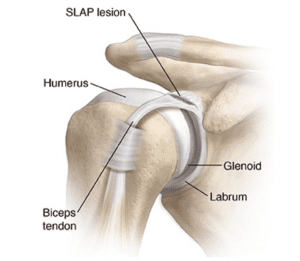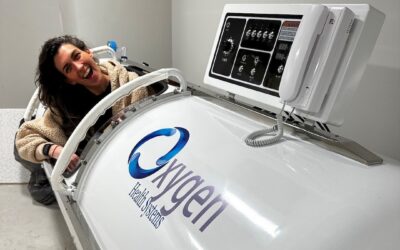A SLAP tear acronym stands for superior labrum anterior posterior. It is one of the most common athletic shoulder injuries in ball, stick and racquet sports. This injury can be a result of single traumatic event or trauma from repetitive overhead reaching.

Labrum’s role:
A labrum is a ring of cartilage that extends around the socket of the shoulder. It’s role is to make the socket deeper and create more stability for the joint.
How does the labrum get in trouble?
The labrum is exposed to constant friction with rotation of the humeral head. In addition, the superior portion of the labrum is fused with the long head of the biceps anchor as it travels through the shoulder on the way to its final bone attachment just beyond the rim of the socket. The tugging of the biceps tendon with various arm motions creates an additional source of trauma to the labrum that can result in a tear.
Both the friction on the labrum from shoulder motion and the tugging from the biceps tendon are amplified for two reasons:
Shoulders that are loose due to overstretched shoulder ligaments will typically move in a more. uneven fashion causing more injury to the labrum. Loose shoulder ligaments can be part of a person’s overall ligament laxity or a result of a repetitive shoulder overuse from sport activities like pitching. A muscle imbalance around the shoulder will create a tightness of the front shoulder and chest muscles and weak, loose muscles around the back of the shoulder and shoulder blade.
This type of imbalance is typically a result of shoulder over use and lack of a well-balanced physical training program that would stretch the tight front muscles and keep the back of the shoulder muscles strong.
This imbalance forces the ball of the shoulder joint to move forward and out of alignment with the socket. The forward or anterior shoulder misalignment pulls excessively on the long head of the biceps tendon anchor and the superior labrum.
What is PRP:
PRP stands for platelet rich plasma and is a product of a person’s blood. PRP is prepared from blood drawn from a person’s arm at the time of the treatment. When the blood is processed in a certain way the PRP layer becomes 10 times more concentrated than what is normally found in the unprocessed blood sample. PRP is rich in growth factors that are released into the injured tissue upon injection.
How does PRP heal SLAP tears?
PRP or platelet rich plasma contains a high concentration of growth factors that stimulate repair directly and signaling chemicals that attract person’s own stem cells. These in turn both create a much stronger healing response and directly replace the injured tissue.
How is the PRP injected into the labral tear:
PRP Therapy at OWM Integrative Wellness starts with an ultrasound examination to identify the location of the tear. A highly concentrated PRP sample is then guided into the tear under ultrasound visualization to ensure accuracy. The injection is placed in the back, front, and the top of the labrum, covering both the anterior and posterior aspect of the superior labrum. The biceps anchor attachment to the labrum and the bone are also injected. It is also important to treat all other loose shoulder ligaments to restore shoulder joint balance and alignment. This helps prevent future labral tears.
This is different from many other medical facilities where the joint is injected with a single unguided shot without addressing issues with the ligaments and the biceps anchor and without ensuring that the PRP actually ends up in the labral tear. Typically two to three treatments are needed to provoke adequate repair.
What is the expected recovery?
Healing may not start for two to three weeks after injection and commonly two to three injections done four weeks a part are needed to provide significant recovery. There is typically a 2 week period of down time after each PRP session and before a person is allowed to resume normal activities.
What about success rates?
Success rates of this treatment are generally higher than 85% with no significant side effects. Each subsequent treatment builds on the healing from the treatment before, making recovery happen faster and more completely.




